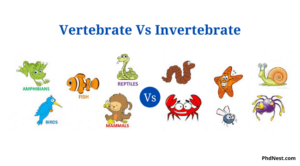The animal kingdom has been isolated into two subgroups: Vertebrates and Invertebrates. The vertebrate column which is also referred to as the backbone is present in some animals, those animals are known as vertebrates. Those animals that do not contain backbone or vertebrate column are known as invertebrates.
What is Invertebrate ?
Invertebrates can be simply identified as animals that do not have a backbone. They are found almost everywhere, from the hottest deserts and the deepest sea beds to the darkest caves and the tallest mountains.
What is PhD : Meaning, How to Do, Benefits, Full Details
What is Vertebrate ?
Vertebrates are the most advanced of species in the animal kingdom. Members possess a well defined internal skeleton system, which includes a backbone. In humans, the spinal cord runs along the body between the caudal and cranial regions connecting to the nerve tissues.
Differences Between Vertebrate And Invertebrate
[ninja_tables id=”3873″]Click Here for Complete Biology Notes
Related Posts
- Phylum Porifera: Classification, Characteristics, Examples
- Dissecting Microscope (Stereo Microscope) Definition, Principle, Uses, Parts
- Epithelial Tissue Vs Connective Tissue: Definition, 16+ Differences, Examples
- 29+ Differences Between Arteries and Veins
- 31+ Differences Between DNA and RNA (DNA vs RNA)
- Eukaryotic Cells: Definition, Parts, Structure, Examples
- Centrifugal Force: Definition, Principle, Formula, Examples
- Asexual Vs Sexual Reproduction: Overview, 18+ Differences, Examples
- Glandular Epithelium: Location, Structure, Functions, Examples
- 25+ Differences between Invertebrates and Vertebrates
- Lineweaver–Burk Plot
- Cilia and Flagella: Definition, Structure, Functions and Diagram
- P-value: Definition, Formula, Table and Calculation
- Nucleosome Model of Chromosome
- Northern Blot: Overview, Principle, Procedure and Results

















